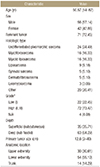Abstract
Purpose
This study examined the diagnostic accuracy of an imaging study to find the factors that affect the presence of residual tumors after an unplanned excision of sarcomas.
Materials and Methods
Ninety-eight patients, who underwent a re-excision after unplanned surgery between January 2008 and December 2014, were enrolled in this study. Magnetic resonance imaging (MRI) was performed before reoperation in all patients. Positron emission tomography (PET)-computed tomography was performed on 54 patients. A wide re-excision and histology diagnosis were performed in all cases. The clinical variables were evaluated using univariate logistic regression and multivariate logistic regression.
Figures and Tables
References
1. Fletcher CDM, Gronchi A. Epidemiology. In : Fletcher CDM, editor. World Health Organization, International Agency for Research on Cancer. World Health Organization classification of tumours of soft tissue and bone. 4th ed. Lyon: IARC Press;2013. p. 14.
2. Kang S, Han I, Lee SA, Cho HS, Kim HS. Unplanned excision of soft tissue sarcoma: the impact of the referring hospital. Surg Oncol. 2013; 22:e17–e22.

3. Davis AM, Kandel RA, Wunder JS, et al. The impact of residual disease on local recurrence in patients treated by initial unplanned resection for soft tissue sarcoma of the extremity. J Surg Oncol. 1997; 66:81–87.


4. Randall RL, Bruckner JD, Papenhausen MD, Thurman T, Conrad EU 3rd. Errors in diagnosis and margin determination of soft-tissue sarcomas initially treated at non-tertiary centers. Orthopedics. 2004; 27:209–212.


5. Giuliano AE, Eilber FR. The rationale for planned reoperation after unplanned total excision of soft-tissue sarcomas. J Clin Oncol. 1985; 3:1344–1348.


6. Noria S, Davis A, Kandel R, et al. Residual disease following unplanned excision of soft-tissue sarcoma of an extremity. J Bone Joint Surg Am. 1996; 78:650–655.

7. Temple HT. Clinical evaluation and treatment of soft tissue tumors. Semin Musculoskelet Radiol. 1999; 3:5–14.


8. Chandrasekar CR, Wafa H, Grimer RJ, Carter SR, Tillman RM, Abudu A. The effect of an unplanned excision of a soft-tissue sarcoma on prognosis. J Bone Joint Surg Br. 2008; 90:203–208.


9. Lewis JJ, Leung D, Espat J, Woodruff JM, Brennan MF. Effect of reresection in extremity soft tissue sarcoma. Ann Surg. 2000; 231:655–663.



10. Potter BK, Adams SC, Pitcher JD Jr, Temple HT. Local recurrence of disease after unplanned excisions of high-grade soft tissue sarcomas. Clin Orthop Relat Res. 2008; 466:3093–3100.



11. Venkatesan M, Richards CJ, McCulloch TA, et al. Inadvertent surgical resection of soft tissue sarcomas. Eur J Surg Oncol. 2012; 38:346–351.


12. Hoshi M, Ieguchi M, Takami M, et al. Clinical problems after initial unplanned resection of sarcoma. Jpn J Clin Oncol. 2008; 38:701–709.

13. Goodlad JR, Fletcher CD, Smith MA. Surgical resection of primary soft-tissue sarcoma. Incidence of residual tumour in 95 patients needing re-excision after local resection. J Bone Joint Surg Br. 1996; 78:658–661.

14. Manoso MW, Frassica DA, Deune EG, Frassica FJ. Outcomes of re-excision after unplanned excisions of soft-tissue sarcomas. J Surg Oncol. 2005; 91:153–158.

15. Fiore M, Casali PG, Miceli R, et al. Prognostic effect of re-excision in adult soft tissue sarcoma of the extremity. Ann Surg Oncol. 2006; 13:110–117.


16. Davies AM, Mehr A, Parsonage S, Evans N, Grimer RJ, Pynsent PB. MR imaging in the assessment of residual tumour following inadequate primary excision of soft tissue sarcomas. Eur Radiol. 2004; 14:506–513.


17. Stojadinovic A, Leung DH, Hoos A, Jaques DP, Lewis JJ, Brennan MF. Analysis of the prognostic significance of microscopic margins in 2,084 localized primary adult soft tissue sarcomas. Ann Surg. 2002; 235:424–434.



18. Sugiura H, Takahashi M, Katagiri H, et al. Additional wide resection of malignant soft tissue tumors. Clin Orthop Relat Res. 2002; (394):201–210.

19. Siebenrock KA, Hertel R, Ganz R. Unexpected resection of soft-tissue sarcoma. More mutilating surgery, higher local recurrence rates, and obscure prognosis as consequences of improper surgery. Arch Orthop Trauma Surg. 2000; 120:65–69.

20. Murphey MD, Kransdorf MJ, Smith SE. Imaging of soft tissue neoplasms in the adult: malignant tumors. Semin Musculoskelet Radiol. 1999; 3:39–58.


21. Kaste SC, Hill A, Conley L, Shidler TJ, Rao BN, Neel MM. Magnetic resonance imaging after incomplete resection of soft tissue sarcoma. Clin Orthop Relat Res. 2002; (397):204–211.

22. Shapeero LG, Vanel D, Verstraete KL, Bloem JL. Fast magnetic resonance imaging with contrast for soft tissue sarcoma viability. Clin Orthop Relat Res. 2002; (397):212–227.

23. Bauer HC, Trovic CS, Alvegård TA, et al. Monitoring referral and treatment in soft tissue sarcoma: study based on 1,851 patients from the Scandinavian sarcoma group register. Acta Orthop Scand. 2001; 72:150–159.


24. Gerrand CH, Bell RS, Wunder JS, et al. The influence of anatomic location on outcome in patients with soft tissue sarcoma of the extremity. Cancer. 2003; 97:485–492.


25. Ilaslan H, Schils J, Nageotte W, Lietman SA, Sundaram M. Clinical presentation and imaging of bone and soft-tissue sarcomas. Cleve Clin J Med. 2010; 77:Suppl 1. S2–S7.

26. Siegel HJ, Brown O, Lopez-Ben R, Siegal GP. Unplanned surgical excision of extremity soft tissue sarcomas: patient profile and referral patterns. J Surg Orthop Adv. 2009; 18:93–98.

27. Morii T, Yabe H, Morioka H, Anazawa U, Suzuki Y, Toyama Y. Clinical significance of additional wide resection for unplanned resection of high grade soft tissue sarcoma. Open Orthop J. 2008; 2:126–129.







 PDF
PDF ePub
ePub Citation
Citation Print
Print






 XML Download
XML Download